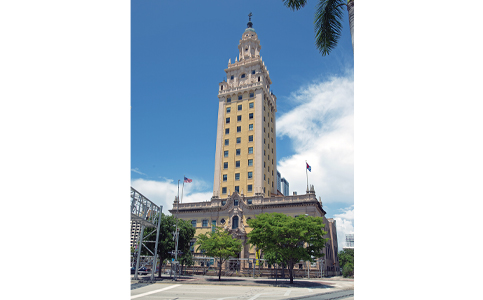Freedom Tower closed for repairs until its 2025 centennial
Advertisement

Miami Dade College’s Freedom Tower officially closed to the public in May to prepare for the building’s capital renovation work.
The $25 million state-funded renovation of the historic 289-foot Freedom Tower at 600 Biscayne Blvd. will focus on urgent structural repairs, like pipes, improving water and sewer infrastructure and outside restoration.
A reopening commemorating the building’s centennial celebration is envisioned in 2025, said Dr. Maryam Laguna Borrego, vice president for external affairs and strategy and chief of staff.
New exhibits will be unveiled then to provide a contemporary visitor experience that tells the story of the Freedom Tower and its significance for Miami, she added.
Once the Freedom Tower reopens, its most famous exhibits will be there, such as the first floor Kislak Collection of rare historical books, manuscripts, maps and Pre-Columbian artifacts that provide insight into the civilizations that shaped the Americas.
The Cuban exile story and Cuban Legacy gallery will reopen as well. The Cuban Legacy gallery shows the Cuban exile influence on the culture in Miami and the Cuban Exile Story has lectures and displays on exile experiences.
“The Freedom Tower embodies Miami’s spirit of hope, courage and opportunity,” said Dr. Borrego. “It is the crown jewel of the city’s skyline and an important historic landmark where our community convenes.”
For nearly a century, in fact, the Freedom Tower has played a central role in Miami’s history. To the many thousands of Cuban refugees seeking asylum between 1962 and 1974, it was a portal to a new life.
But the building’s first tenants were journalists. In 1923 James M. Cox, who lost the 1920 presidential election to Warren G. Harding, bought Miami’s oldest newspaper, the Miami Metropolis, and renamed it Miami Daily News. The Metropolis had been published since shortly before the City of Miami was incorporated in1896. Cox then commissioned the New York architectural firm of Schultze and Weaver to design a skyscraper on prime real estate overlooking Biscayne Bay to accommodate the paper’s offices and printing presses.
“The building’s design makes reference to the Giralda, the bell tower of the twelfth-century Seville Cathedral, which was also the model for the tower portion of the Biltmore Hotel in Coral Gables,” the Society of Architectural Historians website says. “The 17-story, 82,000-square-foot building comprises a slender tower emerging out of a broad, three-story base…. A slender three-story lantern caps the building, and uses a steel structural frame, while the rest of the building is supported by a reinforced concrete frame; both are finished with stucco-clad concrete block and cast-concrete ornamental details.”
The new building, completed in 1925, served as the newspaper’s headquarters until 1957, when the Miami News moved to more modern facilities. The site stood largely unoccupied and neglected for the next five years.
Then global politics changed the tower’s destiny. Following the coup that brought Fidel Castro to power in 1959, Cubans began flying to Miami.
With the enactment in 1962 of the Kennedy Administration’s Migration and Refugees Assistance Act, authorizing help, the federal government leased the first four floors of the building to house the Cuban Assistance Center. The landmark property soon became known as Freedom Tower.
For the next 12 years it was a beacon of hope for Cuban refugees, many of whom had fled with little but the clothes on their backs.
In 1974, when the government began scaling down its Cuban Refugee program, the Cuban Assistance Center was shuttered, and the Freedom Tower once again slipped into neglect. But in 1997 it was rescued. Jorge Mas Canosa, founder of the Cuban American National Foundation, bought the property, with plans to restore it. Although he died just two months later, his family and subsequent owners honored his wishes.
In 2005 the Pedro Martin family donated it to Miami Dade College. It is now a National Historic Landmark.


